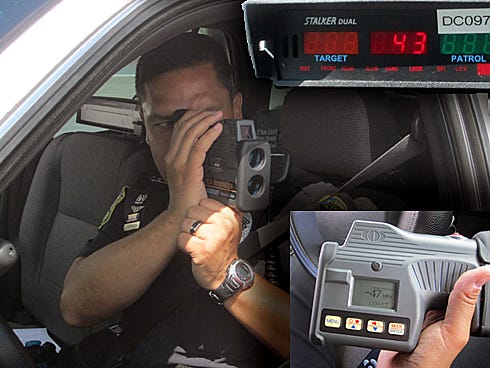
CRESTVIEW — Many local drivers complain about their fellow motorists, but are they as bad as that?
The answer is yes, traffic officers say.
"My belief is the biggest reason we've become bad drivers in the last five years is inattentiveness," Crestview Police Department traffic division officer JoséPereira said.
Watch video of routine Crestview Police Department traffic division enforcement and Officer José Pereira explaining why so many motorists drive poorly>>
Texting, answering and making phone calls, applying makeup, fiddling with onboard electronics and other distractions cause accidents such as rear-end crashes, driving off the road and sideswipes.
"It scares me when people drive the way they do," Pereira. "You can't watch out for the other driver if you're texting or talking on the phone."
And the state's lightweight new law against texting while driving is ineffective, he added, because it is a secondary offense and people know it.
Myths debunked
Pereira debunked some traffic enforcement myths.
•"We have no quota! We're not required to write one ticket or 300 tickets a day," he said. "All we do is enforce traffic law."
•The city makes very little money from traffic tickets
•Police easily defeat radar detectors and jammers
•Plastic license plate shields don't confuse radar or laser.
Thursday morning, Pereira and his partner, Brian Mulbach, were patrolling the city's problem spots.
"Speeders are our biggest problem," Pereira said, followed by impatient drivers running stoplights.
Even as he spoke, Mulbach, staged at the Tom Thumb on the corner or State Road 85 and P.J. Adams Parkway, radioed a description of a tractor-trailer that ran a red light at the intersection.
Drivers breaking the law even when officers are parked and watching traffic is not uncommon. Those drivers are so distracted they don't even notice patrollers, Pereira said.
"I never try to hide," Pereira said. "I have a big, white car. They can see me. There's other places I could sit and be more discreet but I want them to see me and know we're enforcing traffic law."
Poor training
Patrolling 30-mph Aplin Road, where speeding is a problem, Pereira soon netted a 16-year-old Crestview High School student driving 43 mph. Her car had a radar detector — and a classmate passenger.
"This'll probably be all around the high school by lunchtime," Pereira said as he completed the ticket. He hoped the experience would encourage the young driver to be more attentive.
"We try to help people but not everybody realizes it at the time," he said. "Like that young lady: Maybe her parents will give her a little remedial driving training. Maybe instead of giving her a radar detector they'll take it out and teach her to drive the speed limit."
With only one driver education teacher at Crestview High, Pereira said too many young drivers are not receiving thorough training.
"They don't know how to drive on a highway. They don't know how to merge," he said. "They don't know how to do many things because they're not taught it."
Parents, who are supposed to supervise their children's 50 hours of road-driving time required for a driver's license, are often also unskilled, and pass poor driving habits on to the next generation of motorists, Pereira said.
Slowing down, paying attention and obeying red lights would eliminate most of the city's traffic accidents, Pereira said.
"It's a statistical certainty, proven over and over: The more people obey traffic law, the fewer crashes we have," he said.
What we do wrong
Crestview Police officer JoséPereira offers these observations after almost three years in the traffic division:
•No turn signal or incorrect turn signal use: "People don't know what they (turn signals) are. The law is clear: you have to use a turn signal whenever you change course."
•Four-way stop confusion: "People just don't understand what a four-way stop is."
•Distracted driving: "It doesn't frustrate me as much as it scares me, because I know what the potential is."
•Running red lights: "Waiting a couple minutes for it to turn green again is better than losing time to receive a citation, being involved in a wreck or being transported to the hospital."
Biggest traffic problem areas
Crestview Police Department traffic division officers say these are the city's traffic problem areas:
•State Road 85 and U.S. Highway 90 intersection: running a red light
•Aplin Road: speeding
•John King Road: speeding
•S.R. 85 and P.J. Adams Parkway intersection: red light running; failure to stop before right on red
•Brookmeade Drive and Redstone Avenue intersection: four-way stop
•S.R. 85 and Wal-Mart Drive intersection: failure to yield to oncoming traffic; red light running
Contact News Bulletin Staff Writer Brian Hughes at 850-682-6524 or brianh@crestviewbulletin.com. Follow him on Twitter @cnbBrian.
This article originally appeared on Crestview News Bulletin: Yes, we're poor drivers: Speeders, red light runners, inattentive drivers common threats (VIDEO)
